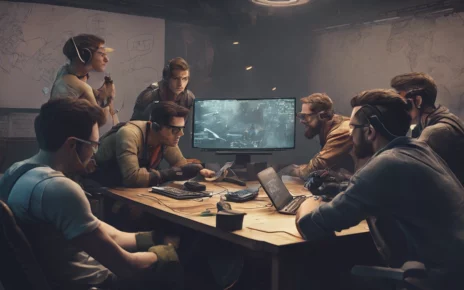Software bugs are the hidden gremlins that can wreak havoc on your favorite games. These issues often arise from coding errors, system incompatibilities, or simple oversights during game development. Even the most polished games aren’t immune, with bugs ranging from minor annoyances to game-breaking glitches that can seriously disrupt your gaming experience.
Why Do Bugs Occur More Frequently in PC Games?
PC games are particularly prone to bugs compared to console games. The main reason lies in the wide variety of hardware and software configurations on PCs. While consoles like PlayStation and Xbox have standardized hardware, PCs must adapt to a wide range of components, operating systems, and drivers. This makes detecting and fixing bugs on PC much more complex and time-consuming.
The Impact of Bugs on Gameplay
Bugs can ruin the immersive experience of gaming, causing anything from minor glitches to severe problems that prevent players from progressing. Imagine your character getting stuck halfway through a wall – amusing at first, but quickly frustrating when it halts your progress.
There are plenty of infamous bugs that gamers still talk about today. Take Cyberpunk 2077’s launch or the flying mammoths in Skyrim—these glitches became iconic but also highlighted the importance of proper bug testing before release.
Why Developers Focus on Fixing Bugs
For game developers, fixing bugs is a priority because player satisfaction is on the line. Bugs can tarnish a game’s reputation, leading to negative reviews that spread quickly and affect sales. A buggy game can also damage a developer’s credibility, making future titles less appealing to the gaming community.
Developers understand that in today’s competitive market, quick responses to bugs are essential for maintaining player loyalty and ensuring long-term success.
The Bug Fixing Process in Game Development
The process of fixing bugs in games is complex, involving several key steps:
1. Identifying Bugs
The first challenge is identifying bugs, often through player reports. Players are usually the first to encounter bugs, providing valuable feedback that helps developers pinpoint issues. The more detailed the bug report, the faster developers can fix the problem.
2. Analyzing and Debugging
Once a bug is reported, developers dig into the code to understand what went wrong. Debugging can be tricky, especially when bugs are deep in the code or interact with multiple systems. Developers use tools like debuggers and integrated development environments (IDEs) to identify and fix issues.
3. Testing and Retesting
After fixing a bug, extensive testing is crucial to ensure that the fix doesn’t create new issues. This step is akin to quality assurance, ensuring that the game runs smoothly across different platforms and settings.
Challenges Developers Face in Bug Fixing
Not all bugs are easy to fix. Some bugs are deeply embedded in the game’s code, while others involve multiple systems, making them harder to isolate. Fixing one bug can sometimes create new problems, requiring even more debugging and testing.
Console vs. PC Bug Fixing
While fixing bugs on consoles is relatively straightforward due to standardized hardware, PC games pose a greater challenge. Developers must account for the wide variety of hardware configurations, operating systems, and software drivers, making the process more complicated.
Software updates and patches are critical in maintaining a bug-free game environment. These updates fix existing bugs and often prevent new ones from occurring as the game evolves. Developers must constantly monitor the game to ensure bugs don’t resurface.
New Technologies in Bug Fixing: Automation and AI
Game development is evolving, and new technologies are helping developers improve efficiency in bug fixing. Automated testing and AI-driven debugging are becoming more popular, allowing developers to catch potential bugs faster and with greater accuracy.
These technologies reduce the time developers spend on manual bug hunting, ensuring a smoother experience for players by identifying issues before they even arise.
The Role of Players in Bug Reporting and Fixing
Player involvement in bug reporting is essential for the bug fixing process. Gamers often encounter issues before developers do, making bug reports a critical part of game improvement. A good bug report includes specific details like the steps to reproduce the bug and the platform in use, helping developers resolve issues faster.
Early access and beta testing also play a significant role in bug detection. Players get to experience fresh content, while developers use real-world data to identify and fix bugs before the official release. This symbiotic relationship helps improve game quality and provides players with more polished experiences.
Community and Modder Contributions to Bug Fixing
Gaming communities, especially modders, often contribute to bug fixing. These passionate gamers take it upon themselves to release unofficial patches that enhance game stability, improve user experience, and even fix bugs that developers have missed.
This collaboration between players and developers creates a strong feedback loop, leading to constant game improvement. Community-driven bug fixes and active developer engagement foster player loyalty and enhance the overall gaming experience.
Conclusion: The Importance of Effective Bug Fixing
Bugs are an inevitable part of game development, but effective bug fixing ensures a smoother, more enjoyable gaming experience. Developers, armed with player feedback, advanced tools, and new technologies, are better equipped than ever to tackle bugs and provide regular updates and patches to improve game quality.
When developers actively address bugs, they build trust and loyalty within the gaming community. This leads to higher player satisfaction, stronger game sales, and long-lasting engagement with the game and its future titles.




